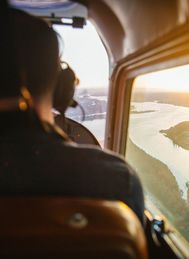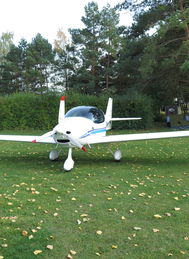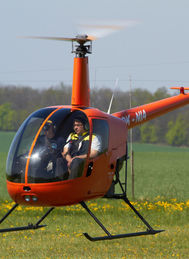Date: June 2, 2013
The first thing that is very beneficial for a possible emergency landing is to simply admit the possibility that your engine could fail on its own at all. Then you will look down upon the ground below with different eyes. A wise pilot, if they have a choice, flies so that they will have a chance to make an emergency landing if the engine stops. For ultralight aircraft, this is even a regulatory requirement. The pilot is responsible for the safe conduct of the flight even in the event of an emergency landing. I don't want to discuss UL flights over the Alps or the sea. Let the pilots concerned evaluate it themselves. The basis of coping with an emergency landing is the possibility to have a landing at all! Remember that. If you are flying from Sazená to Hradec Králové, you can fly directly over quite large forests, or you can only slightly modify the track so that you can fly at the edge of such forests with a chance to slip into the field. This is pretty simple.
Another way you can either avert the inconvenience, or at least increase your chances of managing an emergency landing correctly is to keep monitoring your motorized instruments. Even a moderately advanced pilot can easily tell if they are flying reasonably straight, fast, and at the same altitude without watching the flight instruments, but even the greatest sense of flight and experience will not help you to notice a drop in fuel pressure without checking the instruments. So shift more and more attention to motor instruments. I heard a very experienced pilot say that he could imagine his flight without a speedometer, but that he wouldn’t fly without a fuel pressure gauge. And he's right.
If you find any discrepancies in the engine information during the flight, of course, appropriate to the situation, deal with the problem. In our conditions it is just a short distance to any airport in most cases.
But what do you do if the engine really stops? If you have an aircraft with two tanks, switch to the other without any thought and turn on the fuel auxiliary pump. This will solve 90% of emergency landings on such an aircraft. In most cases you do not even have to start the engine again; the running propeller will start it on its own, when the fuel is restored.
In aircraft with one tank there is nowhere to switch (except in the case of takeoff with the fuel tap closed) so you must prepare for landing in the field. Of course, you can try to start the engine again, but only do this if you have a really great height and a lot of time. It is a great mistake to waste time at a low altitude in vain attempts to start the engine, while crashing into the trees beside a mowed meadow.
The regulation stipulates that the pilot should set the emergency code on the transponder and make an emergency call at the available frequency, but this is again more for airplanes flying somewhere where you have tens of minutes of time before the ground comes. In small aviation, we mostly fly at "dog heights" and so we do not waste time with some tuning of transponders. But the first thing you need to do is maintain speed! Remember, speed keeps you alive! It depends on at what stage of the flight the failure occurred. If it is in a level flight, a well-constructed aircraft will not dangerously lose speed. Even if the pilot was sleeping, the aircraft will automatically lower the bow when power is lost and it will keep the speed safe. If, however, the fail occurs during a climb (and the most dangerous of which is a climb after takeoff), then you have to swiftly and for some aircraft even dramatically respond with the joystick. Maintaining speed is your first concern. No matter what is in front of you, what the surface is, and where you bring the plane to, you must have speed. Even lowering from the right speed to the tops of trees or piles of rocks is better than getting stuck in the same spot in a beginning spiral.
If we have speed, our subsequent concern must be about the position of the ball. Hold it in the middle. I am constantly explaining to all my pupils that when the engine fails, they must repeat "ball, speed, ball, speed" all the way to the ground. Except in the case of some unfortunate crash into an obstacle, perhaps all who died in an unmanaged emergency landing died of a loss of speed and the consequent unsymmetrical breakaway of the nozzles on the wing. BALL-SPEED!
Well. You fly at the right speed, you can handle the ball, what next? Here it depends on your height above the ground and the type of aircraft you are sitting in. You have to choose the landing area accordingly. How to know where the plane will fly to? Well, it was your basic training. Reasonable instructors mainly want to demonstrate emergency procedures when flying and checking. That is precisely for you to understand the aircraft that you are flying with in the air. Always try to land against the wind (and please be careful, if I write here "always", I mean "whenever possible." Of course, the tree of life is so wide that I can't judge all possible combinations of situations that could ever happen. Common sense must be used to solve the situations). Just one meter in the back makes it difficult to land, change budgets, extend stamina and you will land on the ground with much more speed. At five meters in the back, the landing will probably not turn out well unless you are sitting on a very long and very flat surface.
The first choice in the selection of areas should be dry, harvested, cultivated area. Plainly spoken - a mowed field. That is often much better than a rarely cut meadow. Land by line. And even if it's stubble. There are always tracks from a combine harvester or tractor, and you would probably lose at least a chassis when landing across it. Sure, you may say "to hell with the chassis, what’s important is that I'm alive"! And you're right. But not everyone is oblivious to what happens to their aircraft and most importantly - no one has been injured in a plane which remained intact. So if the plane is full after landing, you certainly will. And a broken bow may not just end up with a plane on its nose, but also with a somersault, and there is very often an accident.
If it is obvious that you are going to land on the ground, have the correct speed and area selected, close the fuel cap and turn off the main power switch. It can save your life. If you have a high-altitude aircraft, or an aircraft with a fixed cabin and doors, it is better to unlock the doors before landing to prevent them from jamming and trapping you inside (as is the case with the Piper PA 28, for example).
Make a budget for landing to about one third of the selected area (if the area is long enough). You can shorten with large flaps, slip, or “s” bends. This is based on the nature of the pilot and the type of aircraft (such a Cessna must not do a slip when the flaps are extended, but its large flaps are so effective that it is not even necessary). Always make the final touchdown on the big flaps and try to pull off the finest and most careful landing you've ever made. There is a big difference if the wheels touch the soft surface at a speed of 80 or 60 km. And since landing on the ground often occurs in all sorts of uneven and soft areas, try to really prolong the landing as much as possible and lose speed.
Watch out for the cables! When landing on the ground, we always run the risk of hitting cables. If you see the cables themselves, it's too late. You have to look out for the electric columns. But the fact that there are cables on our surface does not necessarily mean that it is not suitable for landing. The cables are relatively high above the ground and if we touch the ground in front of them, we can run under the cables completely reliably. I would not recommend, however, flying under them, when the aircraft is still in the air. We may not estimate such a maneuver correctly. It is also dangerous to fly over them at a low altitude. In such a case, if we do not make an accurate estimate, or if the decline increases, there may not be a solution. In this case, it is better to look for some other solution, a different area, or to carry the budget somewhere further behind the cables.
What to do with high growth? Here the answer is simple, regardless of the height of the crop, always lower to the tops! Whether it is corn, oats or mature spruce trees, always lower to the top! Here I would like to mention the beautiful, yellow, ecological and most of all VERY DANGEROUS oilseed rape. The rape creates a very dense and firm growth that will not allow you to move, will immediately grab you by the wheels and will almost always cause you to fall over onto your back. If possible, avoid the rape. It's crap in fuel and on the ground!
How to get into the water? In our conditions, although I do not see a great reason to sit in the water, if the pilot maintains at least the basic principles of safety, well ok. If this happens to you, then in addition to all the above principles, be sure to open the doors or hinged windows before landing. After sinking, you will need to get out of the seat belts quickly, but do not unfasten them before touching the surface. It will be hard! On the contrary, tighten your belts and fasten your shoulder straps. You should have it on in advance when flying over water. And one important thing, keep your wheels firmly braked during the contact with water! A standing wheel acts as a float for a while and glides on the surface. A running wheel, on the other hand, pulls the plane sharply under the surface and brakes on the spot. Being somehow wise about landing on the surface is hard, pilots have tried it throughout the war and found out safely that it is never safe. Try to avoid water.
When to return to the airport and when to land on the ground? It depends a lot on the type of aircraft, the strength and direction of the wind, as well as the size of the airport. Of course, when failing shortly after takeoff, the airport is somewhat magnetic and attracts the pilot with great force. However, it is always very important to recognize if it is safe to try to return. Many pilots ending up being injured simply because they tried "at any cost" to return to the place they took off from. Some aircraft glide more and you can afford to go back after the first turn. Some cannot make it after the second turn. But before the first corner, I wouldn't try with any. You must know the capabilities of your aircraft as pilots. And decide accordingly. It is safer to land nicely in the field in front of the airport than with a spiral crashing into the airfield. This can only be recognized by repeated training. Just don’t try to get to the airport at that "any cost" mentality. Such a cost can be very high.
What about the rescue system? The installed rescue missile system is similar to a back parachute. Use it in the same cases. Would you jump out of a light aircraft that has a failed engine, or would you try to make an emergency landing? I suppose you'd better try the emergency landing. Handle the rescue system in the same way. If the aircraft is flying, fly it. Use the rescue system if the aircraft is unmanageable, after some massive airframe damage or so on. If the engine stopped because the pilot ran out of gasoline and then they blast off the rescue device, it is proof of their lack of sense. Remember that when you pull the red lever, you are no longer a pilot and you become a spectator, albeit a very involved one. This is really the last chance in case the plane, for example, is missing the elevator and falls anyway, without the possibility to fly it somehow.
With or without a chassis? If you have an airplane with a retractable chassis, the question is whether to open it into the terrain. If you see a really beautiful, flat and hard surface below, then you won’t cause any damage to the aircraft when landing on wheels and you will be a famous pilot. But if you turn the plane over on its back when landing on the chassis due to an ineligible surface, you will be the opposite of the celebrated pilot. So it depends on the surface. Landing on the “stomach” will always slightly damage the plane, but it probably won’t be fatal. You also need to think about how long it takes for the chassis to open. Some electrically opened devices need half a minute to do so, and this is a long time when the earth is fast approaching! Believe me. With such material I would prefer to land on the “stomach” at a low height.
To conclude, an emergency landing is always a dangerous thing, and be careful to avoid it before and every time you fly. During my more than 7,000 hours, I went to the ground sixteen times, and I've always been lucky. But I am not going to tempt it unnecessarily, and I certainly do not think I can totally rely on my emergency landing solution. Good-quality training will teach you to fill the ticket in correctly. How lucky you are, however, is something you don't know. But without a ticket, you never have a chance in any lottery!
Emergency training is one of the most important parts of any flight training. And constant repetition is a must. Do not hope that if you were trained as a pilot five years ago, you will still have an estimate of where and under what wind the aircraft will fly without an engine. It is necessary to test it periodically. It is best when flying with an instructor at the beginning of the season, especially if you limit flying during winter. May you master the art of emergency landing as best as you can and never need it.







